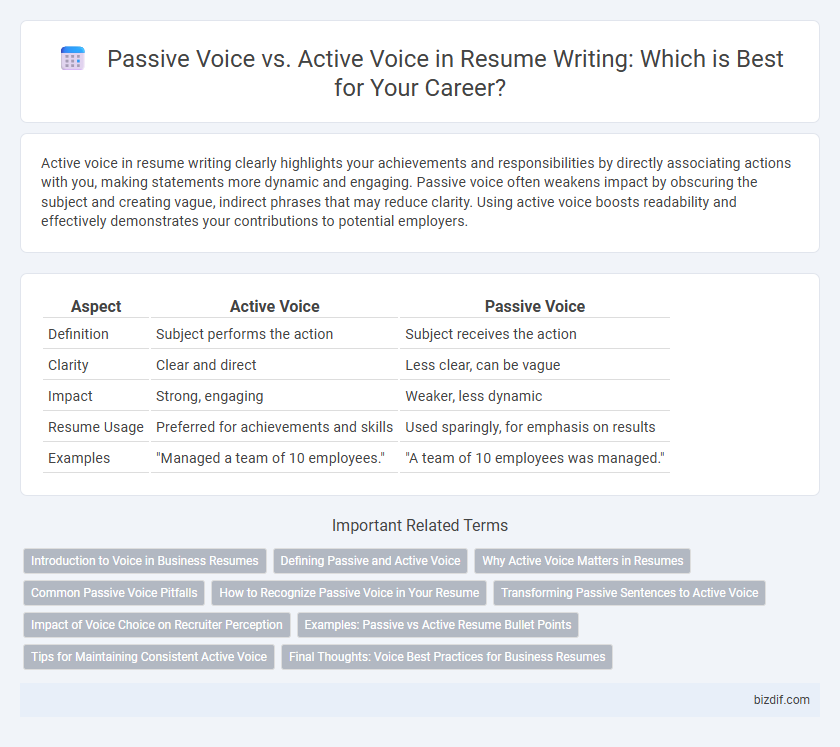Active voice in resume writing clearly highlights your achievements and responsibilities by directly associating actions with you, making statements more dynamic and engaging. Passive voice often weakens impact by obscuring the subject and creating vague, indirect phrases that may reduce clarity. Using active voice boosts readability and effectively demonstrates your contributions to potential employers.
Table of Comparison
| Aspect | Active Voice | Passive Voice |
|---|---|---|
| Definition | Subject performs the action | Subject receives the action |
| Clarity | Clear and direct | Less clear, can be vague |
| Impact | Strong, engaging | Weaker, less dynamic |
| Resume Usage | Preferred for achievements and skills | Used sparingly, for emphasis on results |
| Examples | "Managed a team of 10 employees." | "A team of 10 employees was managed." |
Introduction to Voice in Business Resumes
Active voice in business resumes clearly highlights the candidate's actions and achievements, making statements more direct and impactful. Passive voice tends to obscure the subject, often resulting in weaker and less engaging descriptions of responsibilities and skills. Using active voice enhances readability and effectively showcases accomplishments to potential employers.
Defining Passive and Active Voice
Active voice emphasizes the subject performing the action, creating clear and direct sentences ideal for resume bullet points. Passive voice occurs when the subject receives the action, often resulting in less dynamic statements that may obscure responsibility. Using active voice in resumes highlights accomplishments and skills more effectively, making the candidate's contributions unmistakable.
Why Active Voice Matters in Resumes
Employing active voice in resumes clearly highlights your achievements and responsibilities, making your contributions more impactful and easier for hiring managers to understand. Active voice emphasizes action and ownership, demonstrating confidence and initiative, which are key traits employers seek. Resumes with active voice tend to be more concise and dynamic, enhancing readability and engagement.
Common Passive Voice Pitfalls
Using passive voice in resumes often leads to vague and impersonal statements, weakening the impact of achievements. Common passive voice pitfalls include unidentifiable subjects and diluted action, which can obscure individual contributions and reduce clarity. Employing active voice with strong verbs clearly highlights responsibility and results, making the resume more compelling to employers.
How to Recognize Passive Voice in Your Resume
Passive voice in a resume can be identified by phrases where the subject receives the action, often using forms of "to be" plus a past participle, such as "was managed" or "projects were completed." Look for sentences that emphasize the action being done rather than who performed it, which can make achievements appear less direct. Replacing passive constructions with active voice enhances clarity by clearly showcasing your role and accomplishments.
Transforming Passive Sentences to Active Voice
Transforming passive sentences to active voice in resume writing enhances clarity and impact by clearly identifying the subject performing the action. Active voice improves readability, making achievements and responsibilities more direct and compelling to recruiters. Using active verbs such as "managed," "developed," or "led" emphasizes initiative and accountability in professional experience descriptions.
Impact of Voice Choice on Recruiter Perception
Active voice in resume writing enhances clarity and conveys a sense of ownership and proactivity, making achievements more impactful to recruiters. Passive voice often dilutes the message, reducing the immediacy and strength of accomplishments, which may lead to a weaker impression. Using active voice consistently increases recruiter engagement and clearly highlights the candidate's skills and contributions.
Examples: Passive vs Active Resume Bullet Points
Active voice in resume bullet points clearly highlights achievements, such as "Led a team of 10 to increase sales by 25%," making the candidate appear proactive and results-driven. Passive voice examples like "Sales were increased by 25% by a team of 10" can create vague and weaker impressions. Using active voice ensures clarity and stronger impact, enhancing the resume's effectiveness in demonstrating skills and accomplishments.
Tips for Maintaining Consistent Active Voice
Use strong, clear verbs to maintain active voice in your resume, ensuring that each sentence highlights your direct actions and achievements. Review each bullet point carefully to replace passive constructions like "was managed" or "tasks were completed" with active phrases such as "managed" or "completed tasks." Consistent active voice improves readability and effectively showcases your responsibilities and impact to potential employers.
Final Thoughts: Voice Best Practices for Business Resumes
Using active voice in business resumes clearly highlights accomplishments and responsibilities, making statements more direct and impactful. Passive voice can obscure accountability and reduce the dynamic tone necessary to engage hiring managers effectively. Opt for active constructions to enhance clarity, demonstrate initiative, and maximize persuasive power in your resume content.
Passive Voice vs Active Voice Infographic

 bizdif.com
bizdif.com